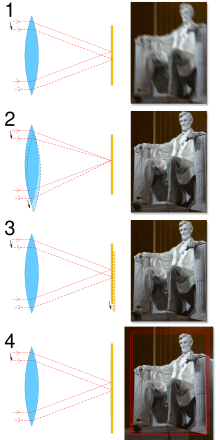
Back Estabilitzador d'imatge Catalan Stabilizace obrazu Czech Billedstabilisering Danish Bildstabilisierung German Estabilizador de imagen Spanish Pildi stabiliseerimine Estonian پایدارکننده نگاره Persian Kuvanvakain Finnish Stabilisation d'image French מייצב תמונה HE

- unstabilised
- lens-based optical stabilisation
- sensor-shift optical stabilisation
- digital or electronic stabilisation
Image stabilization (IS) is a family of techniques that reduce blurring associated with the motion of a camera or other imaging device during exposure.
Generally, it compensates for pan and tilt (angular movement, equivalent to yaw and pitch) of the imaging device, though electronic image stabilization can also compensate for rotation about the optical axis (roll).[1] It is mainly used in high-end image-stabilized binoculars, still and video cameras, astronomical telescopes, and also smartphones. With still cameras, camera shake is a particular problem at slow shutter speeds or with long focal length lenses (telephoto or zoom). With video cameras, camera shake causes visible frame-to-frame jitter in the recorded video. In astronomy, the problem of lens shake is added to variation in the atmosphere, which changes the apparent positions of objects over time.
© MMXXIII Rich X Search. We shall prevail. All rights reserved. Rich X Search